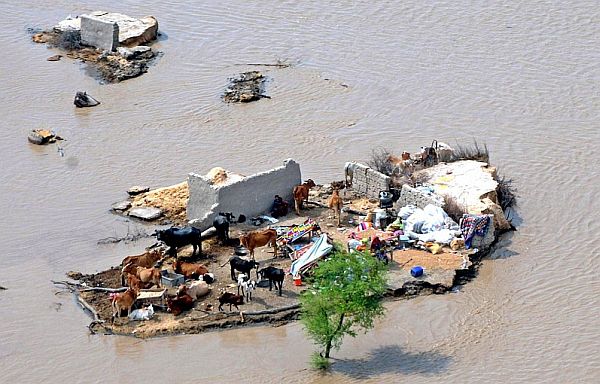At The Atlantic, Max Fisher looks at five long-term effects of the Pakistan floods:
After weeks of flooding in Pakistan displaced two million people and left more than 10 million at risk of disease outbreak because they lack access to clean water, renewed flooding in Pakistan has displaced an additional one million people over the past 48 hours alone, setting back a relief effort that has struggled due to paltry donations. The displaced, often physically inaccessible to relief workers due to Pakistan’s badly damaged infrastructure, face threats of disease, starvation, and dehydration. But even once the immediate humanitarian crises of the flood pass, experts say the floods will leave their impact on Pakistan and the region for years or decades.

Rebecca Barber, from Oxfam, recounts some of the personal losses incurred by individuals:
In a camp in Khairpur, in Sindh, a man told me that he had paid 20,000 rupees ($A260) to evacuate himself and his family from his village when the flood warning came. To cover the costs, he sold the household’s entire crop of wheat. Between himself, his father and his uncle, the family had owned 13 buffalo. But they couldn’t afford to bring them with them when they evacuated, and all drowned when the floodwaters washed through the village. Three of his brothers have stayed behind, camping out on some nearby high land to keep an eye on what’s left of their homes. The village is under more than 1.5 metres of water, and he says he thinks it will be two years before they’ll be able to cultivate again.
In another camp, a man told me that his family had left behind eight goats, two cows and two buffalo when the army evacuated them. He and his family were “tenant farmers” – living on and cultivating the landlord’s land. In addition to the goats, cows and buffalo, they’d owned a small vegetable plot. They’d subsisted day to day on the small profits from the livestock, the vegetables they grew themselves, and a small potion of the landlord’s crops. But the work won’t start again until January next year, when the time for harvesting sugarcane comes around. Until then, he says he’ll go to one of the cities and look for casual labouring work. He won’t get more than 100 rupees (a bit over $1) a day though, nothing like enough to feed a family of 10. And there’s no savings to see them through. His daughter said she’d lost the dowry she’d kept in a trunk for six years: clothes, gold, cooking utensils, and cash.



While the archaeology is in dispute, the Indus/Ghaggar-Hakra River system has periodically given rise to and destroyed earlier civilizations in the region by flooding and shifting river channels since the downfall of Harappan civilization in the Bronze Age. It would be a monumental upheaval if the current foods are no more than precursors of another major shift in geography.
Ironic, if everyone’s eyes have been on low lying countries’ dangers from climate change while the biggest issue has been simmering here in Pakistan. This could be a huge challenge for humanity and its attempts to control and limit the suffering of vulnerable populations — it could evolve to be as big as the collapse of the civilizations of the Sumerian, the Maya, or the Nazca cultures of Peru. And, of course, the Harappan/Mohenjo Daro people of ancient South Asia.
Every Pakistani I heard who lives in the afflicted areas told me that they need this road or that bridge rebuilt within a month…. Well, it turns out that if there’s one thing the West– together with the Sunni Arab states– can do well is rebuild roads and bridges. A quick repair of the infrastructure—politically and profit blind, totally on the basis of local priorities is the first and greatest move the West can make en route to long term recovery. We use Pakistani labor led by a consortium of engineers and skilled construction foremen and workers from the Mideast and Europe and Asia with a one week design of reconstruction scheme time limit and a one month for completion of infrastructure, putting these up within this time limit so the snows will be met with fresh all-weather roads….LESS TALK, MORE ACTION with no Gov interference with know-how. How does that sound?